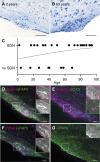The adult human subventricular zone: partial ependymal coverage and proliferative capacity of cerebrospinal fluid
- PMID: 33376983
- PMCID: PMC7750937
- DOI: 10.1093/braincomms/fcaa150
The adult human subventricular zone: partial ependymal coverage and proliferative capacity of cerebrospinal fluid
Abstract
Neurogenesis continues throughout adulthood in specialized regions of the brain. One of these regions is the subventricular zone. During brain development, neurogenesis is regulated by a complex interplay of intrinsic and extrinsic cues that control stem-cell survival, renewal and cell lineage specification. Cerebrospinal fluid (CSF) is an integral part of the neurogenic niche in development as it is in direct contact with radial glial cells, and it is important in regulating proliferation and migration. Yet, the effect of CSF on neural stem cells in the subventricular zone of the adult human brain is unknown. We hypothesized a persistent stimulating effect of ventricular CSF on neural stem cells in adulthood, based on the literature, describing bulging accumulations of subventricular cells where CSF is in direct contact with the subventricular zone. Here, we show by immunohistochemistry on post-mortem adult human subventricular zone sections that neural stem cells are in close contact with CSF via protrusions through both intact and incomplete ependymal layers. We are the first to systematically quantify subventricular glial nodules denuded of ependyma and consisting of proliferating neural stem and progenitor cells, and showed that they are present from foetal age until adulthood. Neurosphere, cell motility and differentiation assays as well as analyses of RNA expression were used to assess the effects of CSF of adult humans on primary neural stem cells and a human immortalized neural stem cell line. We show that human ventricular CSF increases proliferation and decreases motility of neural stem cells. Our results also indicate that adult CSF pushes neural stem cells from a relative quiescent to a more active state and promotes neuronal over astrocytic lineage differentiation. Thus, CSF continues to stimulate neural stem cells throughout aging.
Keywords: cerebrospinal fluid; glial nodules; human; neural stem cells; subventricular zone.
© The Author(s) (2020). Published by Oxford University Press on behalf of the Guarantors of Brain.
Figures








Similar articles
-
Neuroblast proliferation on the surface of the adult rat striatal wall after focal ependymal loss by intracerebroventricular injection of neuraminidase.J Comp Neurol. 2008 Apr 1;507(4):1571-87. doi: 10.1002/cne.21618. J Comp Neurol. 2008. PMID: 18236450
-
Embryonic Cerebrospinal Fluid Increases Neurogenic Activity in the Brain Ventricular-Subventricular Zone of Adult Mice.Front Neuroanat. 2017 Dec 19;11:124. doi: 10.3389/fnana.2017.00124. eCollection 2017. Front Neuroanat. 2017. PMID: 29311854 Free PMC article.
-
Cerebrospinal fluid derived from progressive multiple sclerosis patients promotes neuronal and oligodendroglial differentiation of human neural precursor cells in vitro.Neuroscience. 2013 Oct 10;250:614-21. doi: 10.1016/j.neuroscience.2013.07.022. Epub 2013 Jul 19. Neuroscience. 2013. PMID: 23876320
-
Transcriptional regulation of adult neural stem/progenitor cells: tales from the subventricular zone.Neural Regen Res. 2020 Oct;15(10):1773-1783. doi: 10.4103/1673-5374.280301. Neural Regen Res. 2020. PMID: 32246617 Free PMC article. Review.
-
Understanding How the Subcommissural Organ and Other Periventricular Secretory Structures Contribute via the Cerebrospinal Fluid to Neurogenesis.Front Cell Neurosci. 2015 Dec 23;9:480. doi: 10.3389/fncel.2015.00480. eCollection 2015. Front Cell Neurosci. 2015. PMID: 26778959 Free PMC article. Review.
Cited by
-
Brain-derived neurotrophic factor contributes to neurogenesis after intracerebral hemorrhage: a rodent model and human study.Front Cell Neurosci. 2023 May 11;17:1170251. doi: 10.3389/fncel.2023.1170251. eCollection 2023. Front Cell Neurosci. 2023. PMID: 37252187 Free PMC article.
-
Effect of Multiple Sclerosis Cerebrospinal Fluid and Oligodendroglia Cell Line Environment on Human Wharton's Jelly Mesenchymal Stem Cells Secretome.Int J Mol Sci. 2022 Feb 16;23(4):2177. doi: 10.3390/ijms23042177. Int J Mol Sci. 2022. PMID: 35216294 Free PMC article.
-
Lateral Ventricular Neural Stem Cells Provide Negative Feedback to Circuit Activation Through GABAergic Signaling.Cells. 2025 Mar 13;14(6):426. doi: 10.3390/cells14060426. Cells. 2025. PMID: 40136675 Free PMC article.
-
Proteomic-based evidence for adult neurogenesis in birds and mammals as indicated from cerebrospinal fluid.Neural Regen Res. 2022 Dec;17(12):2576-2581. doi: 10.4103/1673-5374.329002. Neural Regen Res. 2022. PMID: 35662184 Free PMC article. Review.
-
Assessing the Role of Ependymal and Vascular Cells as Sources of Extracellular Cues Regulating the Mouse Ventricular-Subventricular Zone Neurogenic Niche.Front Cell Dev Biol. 2022 Apr 5;10:845567. doi: 10.3389/fcell.2022.845567. eCollection 2022. Front Cell Dev Biol. 2022. PMID: 35450289 Free PMC article. Review.
References
-
- Adams CW, Abdulla YH, Torres EM, Poston RN. Periventricular lesions in multiple sclerosis: their perivenous origin and relationship to granular ependymitis. Neuropathol Appl Neurobiol 1987; 13: 141–52. - PubMed
LinkOut - more resources
Full Text Sources
Other Literature Sources
